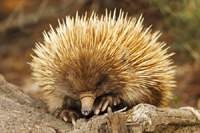What Is an Echidna?

Echidnas, also known as spiny anteaters, belong to the family Tachyglossidae in the monotreme order of egg-laying mammals. There are four extant species, which, together with the platypus, are the only surviving members of that order and are the only extant mammals that lay eggs. Although their diet consists largely of ants and termites, they are only distantly related to the true anteaters of the Americas. They live in New Guinea and Australia. The echidnas are named after a monster in ancient Greek mythology.
Echidnas are small mammals that are covered with coarse hair and spines. Superficially they resemble the anteaters of South America and other spiny mammals like hedgehogs and porcupines. They have snouts which have the functi?ns of both mouth and nose. Their snouts are elongated and slender. They have very short, strong limbs with large claws and are powerful diggers. Echidnas have a tiny mouth and a toothless jaw. They feed by tearing open soft logs, anthills and the like, and use their long, sticky tongue, which protrudes from their snout, to collect their prey. The short-beaked echidna's diet consists largely of ants and termites, while the Zaglossus species typically eat worms and insect larvae. The long-beaked echidnas have tiny spines on their tongues that help capture their prey.
Echidnas and the platypus are the only egg-laying mammals, known as monotremes. The female lays a single soft-shelled, leathery egg twenty-two days after mating and deposits it directly into her pouch. Hatching takes place after ten days; the young echidna, called a puggle, then sucks milk from the pores of the two milk patches (monotremes have no nipples) and remains in the pouch for forty-five to fifty-five days, at which time it starts to develop spines. The mother digs a nursery burrow and deposits the puggle, returning every five days to suckle it until it is weaned at seven months. The average wild echidna can grow as old as 16 years.
Male echidnas have a four-headed penis. During mating, the heads on one side "shut down" and do not grow in size; the other two are used to release semen into the female's two-branched reproductive tract. The heads used are swapped each time the mammal copulates.
Contrary to previous research, the echidna does enter REM sleep, albeit only when the ambient temperature is around 25°C. At temperatures of 15°C and 28°C, REM sleep is suppressed.
|